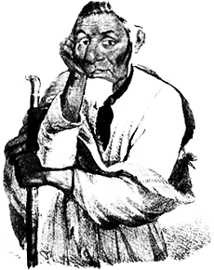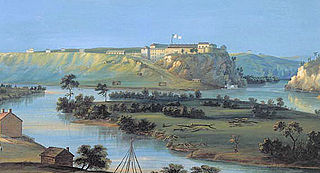
Manuel Lisa, also known as Manuel de Lisa, was a Spanish citizen and later, became an American citizen who, while living on the western frontier, became a land owner, merchant, fur trader, United States Indian agent, and explorer. Lisa was among the founders, in St. Louis, of the Missouri Fur Company, an early fur trading company. Manuel Lisa gained respect through his trading among Native American tribes of the upper Missouri River region, such as the Teton Sioux, Omaha and Ponca.

The Kaskaskia were one of the indigenous peoples of the Northeastern Woodlands. They were one of about a dozen cognate tribes that made up the Illiniwek Confederation, also called the Illinois Confederation. Their longstanding homeland was in the Great Lakes region. Their first contact with Europeans reportedly occurred near present-day Green Bay, Wisconsin, in 1667 at a Jesuit mission station.

Events from the 1680s in Canada.

The Illinois Country — sometimes referred to as Upper Louisiana — was a vast region of New France in what is now the Midwestern United States. While these names generally referred to the entire Upper Mississippi River watershed, French colonial settlement was concentrated along the Mississippi and Illinois Rivers in what is now the U.S. states of Illinois and Missouri, with outposts in Indiana. Explored in 1673 from Green Bay to the Arkansas River by the Canadien expedition of Louis Jolliet and Jacques Marquette, the area was claimed by France. It was settled primarily from the Pays d'en Haut in the context of the fur trade. Over time, the fur trade took some French to the far reaches of the Rocky Mountains, especially along the branches of the broad Missouri River valley. The French name, Pays des Illinois, means "Land of the Illinois [plural]" and is a reference to the Illinois Confederation, a group of related Algonquian native peoples.
Pierre-Charles Le Sueur was a French fur trader and explorer in North America, recognized as the first known European to explore the Minnesota River valley.
The history of Wisconsin encompasses the story not only of the people who have lived in Wisconsin since it became a state of the U.S., but also that of the Native American tribes who made their homeland in Wisconsin, the French and British colonists who were the first Europeans to live there, and the American settlers who lived in Wisconsin when it was a territory. Since its admission to the Union on May 29, 1848 as 30th state, Wisconsin has been ethnically heterogeneous, with Yankees being among the first to arrive from New York and New England. They dominated the state's heavy industry, finance, politics and education. Large numbers of European immigrants followed them, including German Americans, mostly between 1850 and 1900, Scandinavians and smaller groups of Belgian Americans, Dutch Americans, Swiss Americans, Finnish Americans, Irish Americans and others; in the 20th century, large numbers of Polish Americans and African Americans came, settling mainly in Milwaukee. Politically the state was predominantly Republican until recent years, when it became more evenly balanced. The state took a national leadership role in the Progressive Movement, under the aegis of Robert M. La Follette, Sr. and his family, who fought the old guard bitterly at the state and national levels. The "Wisconsin Idea" called for the use of the higher learning in modernizing government, and the state is notable for its strong network of state universities.

Louisiana or French Louisiana was an administrative district of New France. Under French control 1682 to 1762 and 1801 (nominally) to 1803, the area was named in honor of King Louis XIV, by French explorer René-Robert Cavelier, Sieur de la Salle. It originally covered an expansive territory that included most of the drainage basin of the Mississippi River and stretched from the Great Lakes to the Gulf of Mexico and from the Appalachian Mountains to the Rocky Mountains.

Fort Pontchartrain du Détroit or Fort Detroit was a fort established on the west bank of the Detroit River by the French officer Antoine de la Mothe Cadillac in 1701. In the 18th century, French colonial settlements developed on both sides of the river, based on the fur trade, missions and farms.

Nicolas Perrot (c.1644–1717), a French explorer, fur trader, and diplomat, was one of the first European men to travel in the Upper Mississippi Valley, in what is now Wisconsin and Minnesota.

Perrot State Park is a state park in Wisconsin's Driftless Area at the confluence of the Trempealeau and Mississippi rivers. The 1,270-acre (514 ha) park features views of steep limestone bluffs and the river valleys. It has observation platforms for watching wildlife, including the variety of birds which inhabit or migrate through the park. Hiking trails and camping are available. Mountain bike trails penetrate deep inside the park.
The Lewis Cass expedition of 1820 was a survey of the western part of Michigan Territory led by Lewis Cass, governor of the territory. On January 14, 1820, United States Secretary of War John C. Calhoun authorized Cass to lead a party of scientists, soldiers, Canadian voyageurs, and Native Americans into the wilderness of western Michigan Territory. The purpose of the expedition was to:
Ocooch Mountains are a place name for the Western Upland area of Wisconsin also known as the Driftless Region, meaning un-glaciated, lacking glacial drift or the Paleozoic Plateau, referring to a geologic era, Greek for "ancient life". The lack of glaciated terrain accounts for high hills, bluffs, and ridges. The Chippewa, Black, La Crosse, Kickapoo, Baraboo, Lemonweir, Pine, Wisconsin, Grant, Platte and Pecatonia rivers and their tributaries create deeply eroded valleys that contrast the nearby peaks. One dramatic example is Wildcat Mountain State Park. The Baraboo Range anchors the east eastern edge where the Wisconsin River turns and runs through the area to the Mississippi River. The Baraboo Range is a monadnock in Sauk County and a National Natural Landmark formed 1.6 billion years ago featuring Devil's Lake, an endorheic lake.

The Pays d'en Haut was a territory of New France covering the regions of North America located west of Montreal. The vast territory included most of the Great Lakes region, expanding west and south over time into the North American continent as the French had explored. The Pays d'en Haut was established in 1610 and dependent upon the colony of Canada until 1763, when the Treaty of Paris ended New France, and both were ceded to the British as the Province of Quebec.

The territorial era of Minnesota lasted from the Louisiana Purchase in 1803 to Minnesota's achieving statehood in 1858. The Minnesota Territory itself was formed only in 1849 but the area had a rich history well before this. Though there was a long history of European presence in the area before 19th century, it was during the 19th century that the United States began to establish a firm presence in what would become Minnesota.
Fort Trempealeau was founded in 1685 by Nicholas Perrot and a groupe of Canadiens. In the fall of 1685, Perrot and his men arrived at Mont Trempealeau by canoe. The Winnebagos called this mountain, Hay-nee-ah-cheh, or the mountain in the water. That is why Perrot called it in French, la montagne qui trempe à l'eau, or Trempealeau mountain. There, Perrot and his men built a protective shelter in preparation for winter. Several weeks earlier they had left La Baye Green Bay and crossed Wisconsin via the Fox and Wisconsin Rivers to reach the Mississippi Valley. The purpose of this expedition was to establish alliances with the Ioway and Dakota Indians in order to expand French interests in the fur trade market. Although Perrot's venture was not the first French excursion into the upper Mississippi Valley, his was the first attempt to establish a foothold in this region. In the spring of 1686 the Trempealeau site was abandoned for a more advantageous location along Lake Pepin where Perrot built Fort Saint Antoine. Over the next thirty-five years French economic fortunes in the upper Mississippi Valley waxed and waned. It was not until 1731, and the end of the Fox Indian wars, that the French under the command of René Godefroy, sieur de Linctot returned to Trempealeau and established another trading post.

French people have been present in the U.S. state of Nebraska since before it achieved statehood in 1867. The area was originally claimed by France in 1682 as part of La Louisiane, the extent of which was largely defined by the watershed of the Mississippi River and its tributaries. Over the following centuries, explorers of French ethnicity, many of them French-Canadian, trapped, hunted, and established settlements and trading posts across much of the northern Great Plains including the territory that would eventually become Nebraska, even in the period after France formally ceded its North American claims to Spain. During the 19th century, fur trading gave way to settlements and farming across the state, and French colonists and French-American migrants continued to operate businesses and build towns in Nebraska. Many of their descendants continue to live in the state.














